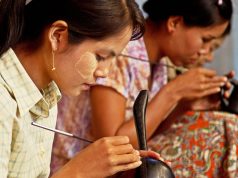Myanmar has about 135 ethnic groups. The Karens make up approximately 7% of the total Myanmar population, with approximately 5 million people. It constitutes the third biggest ethnic population after the Myanmar and the Shans. The term “Karen” is an umbrella term that refers to a heterogeneous lot of ethnic groups that do not share a common language, culture and religion or material characteristics. A large number of Karens have migrated to Thailand, having settled mostly on the Thailand– Myanmar border. There are seven different recognized Karen groups: S’gaw Karen, Pwo Karen, Bwe Kardance is Karen Done Yaine, a group dancing by Karen people.
The Karen drum is a symbol of Karen culture. It is round and made of cast bronze, often decorated with figures of frogs and elephants. Another instrument is the large wooden guitar and the pa ku, a bamboo xylophone played with hammers. There are also bamboo panpipes and mouth-harps of various sizes.
Religion
Most Karens are Buddhists or Animists (believers in spirits). There is also significant population of Christians. There is considerable interplay between Animist rituals and Buddhist practices among the Karens. There are Buddhist monasteries in most Karen villages and the monastery is the centre of community life.
About one hundred and fifty years ago Christian missionaries started working with the Karens and about 15% of Karen people are now Christians. Most Karen Christians are Baptist but some are Anglican, Catholic or Seventh Day Adventists.
Language
The Karen languages consist of three branches: S’gaw, Eastern Pwo and Western Pwo. The common language is generally S’gaw as a lot of the Pwo Karen speaks S’gaw, but the S’gaw Karens do not necessarily speak Pwo. It is very important to have interpreters who can speak S’gaw. Some of the Pwo Karen from the city do not speak S’gaw at all, but will speak Myanmar language. A small percentage of Karens speaks the Thai language.
Names
Traditionally, the Karens do not have family names. Married couples also do not share the same surname. Usually Karen names mean something. In S’ghaw Karen: grandma (Pi) and grandpa (Pu), older brother (Jaw), older sister (Naw), auntie (Muah), uncle (Di). Thra and Thramu are used for teachers and pastors. Saw is for Mr. and Naw is for Ms. In Pwo Karen, Sa is for Mr and Nant is for Ms.
Traditional Food
Karen people traditionally live in the forests and seldom visit nearby towns. Rather than buying food in the market, Karen people searched for delicacies in the forest. The followings are some popular Karen foods and recipes.
Talapaw
A favorite dish for Karens in the forest is “Talapaw”, made by adding a handful of rice and some shreds of dried meat to boiling water, letting it cook until the meat and rice are soft like porridge and then adding some chopped vegetables.
Da-poh-poh
The dish consists of the tiny pieces of rice, which are placed in boiling water and stirred to make a thick sauce-like mixture. Various vegetables such as bamboo and pumpkin are added, as well as meat such as pork or chicken to taste. A variety of herbs, onion and chili gives the dish a rich flavor.
Traditional Dress
Karens wear tunics and sarongs of homespun cotton, dyed red, blue and black. Men and married women wear a loose tunic over a wrapped sarong. The unmarried girls wear simple, long white dresses in Sgaw Karen. Pale yellow powder paste called ‘thanakhar’ may be painted on cheeks, forehead and arms.
Places of Interests
There are many famous places to go around Kayin State. Some of them are:
Mount Zwegabin
The Zwekabin Hill has a very unusual shape, which, once seen, is not easily forgotten. It is the landmark of the Kayin state. The mountain is near the capital city of Hpa An.
Kawcun Cave
Kawcun cave is located near Kawcun village, roughly two miles distance from Hpa-An Township. It is a natural lime stone cave and the rock surface is profusely decorated with different kinds of clay Buddha images and votive tablets.
Kyauk Kalatt
The column or rock, standing tall out of a lake makes this monastery, pagoda and Nat shrine one of the most photographed spots in all Kayin State. This is a popular pilgrimage site close to Hpa-An town.
Sadam Cave
This breathtakingly huge cavern contains a pagoda near the entrance with many Buddha images. Further inside the cave it becomes a dark and wild place with many huge stalactites and the home of a large bat population. Continue to the end of the cave to find a hidden lake underneath in the mountains.
Shwe Yin Myaw Pagoda
It is located in Hpa-An at the Thanlwin River, Kayin State. It is about 9 meters high and called Taunglaygon Shwe Yin Myaw in Myanmar.
The Flag
In Karen flag design, the rising sun symbolizes that the Karen nation will always shine to the world with brightness and success. Nine rays of light streaming from the rising sun indicated the nine regions from which the Karen people traced their origins to. The frog drum symbolizes unity in traditional Karen culture. In 1936, Karen army leaders added two dohs (rounded seeds) under the frog drum in the Karen flag. Karen people have used the Karen national flag during wrist tying ceremonies, cultural, public meetings and especially during Karen New Year.
Karen National Day
After Myanmar Independence in 1948, Karen people demonstrated on February 11 demanding their own land. Since then, every year on February 11, they celebrate National Karen Day by putting up the national flag, eating, singing and dancing, according to Karen traditional customs.










